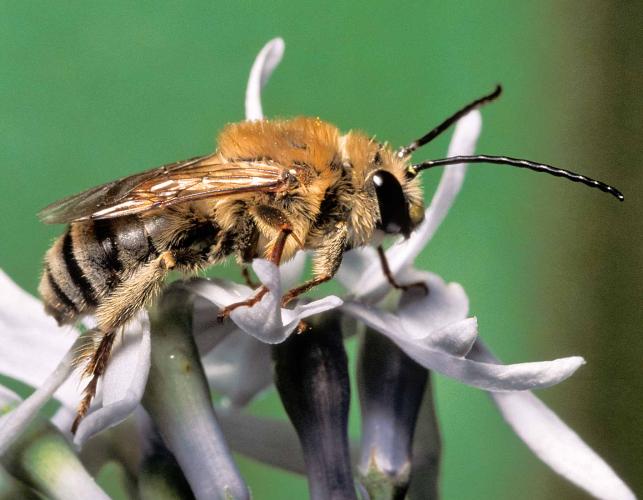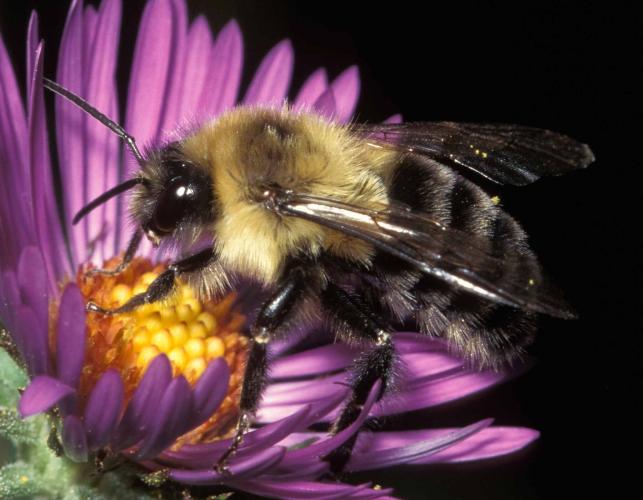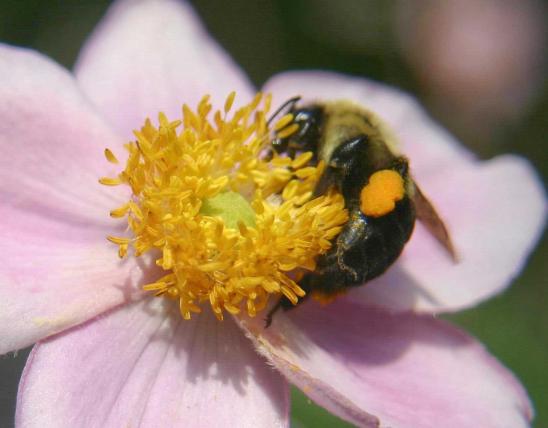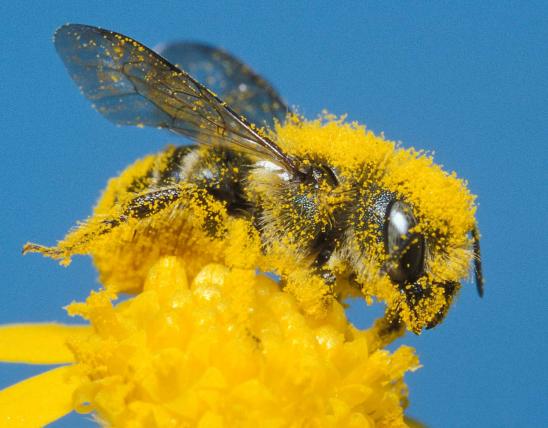
Apid bees constitute one of the main families of bees in Missouri. This family includes several well-known species, plus many, many more relatively unknown ones.
Among the more famous apids are:
- European honeybee (Apis mellifera), the famous colony-living bee species that creates honey. It's the official Missouri state insect.
- Large carpenter bees (Xylocopa spp.), with their shiny, hairless abdomens and habit of excavating nest tunnels into wood. The eastern carpenter bee (X. virginica) is Missouri's only representative in this genus.
- Bumblebees (Bombus spp.), large, colony-living bees with fuzzy abdomens. Females have pollen baskets (corbiculae) on the hind legs. There are about 46 species in North America north of Mexico; Missouri has at least 6 species.
Some less well-known members of this family include:
- Digger bees (Anthophora spp.) are usually medium-sized. Many look like small, fast, sometimes grayish bumblebees. They dig nest tunnels into the ground, often constructing entrance chimneys out of mud. Some species, such as the abrupt digger (A. abrupta), build in large aggregations on vertical dirt surfaces such as the bottoms of cliffs or on banks. Although gregarious, they are solitary. They are not aggressive. There are more than 50 species in this genus in North America north of Mexico.
- Longhorn bees (including Eucera and Melissodes spp.) are named for their long antennae, which make these medium-sized bees look rather cute. Many have yellow faces. Most have very particular types of plants they pollinate. One longhorn species, the worthy longhorn (Florilegus condignus), specializes in pollinating the various types of pickerel weeds (Pontederia spp.).
- Squash bees (Peponapis and Xenoglossa spp.) only collect pollen from squashes, gourds, and pumpkins (Curcurbita spp.), and they are extremely important in the pollination of these plants. They are active surprisingly early in the day, just when squash flowers are opening. They are often trapped when the squash blossom wilts closed on them in the midday heat. They can cut their way out of the flower if it gets too hot. Meanwhile, they become covered with pollen as they move around in their little squash-blossom shelter, and once free, they move the pollen to the stigma of another plant.
- Cuckoo bees, including cellophane-cuckoo bees (Epeolus spp.), longhorn-cuckoo bees (Triepeolus spp.), and nomad bees (Nomada spp.): these are all cleptoparasites (robber parasites) of other bees. They sneak into the nests of other bees and lay eggs on the wall. The cleptoparasitic larvae hatch first and eat up the food provisions intended for the rightful larva. These cleptoparasites are usually limited to certain types of host bees.
- Small carpenter bees (Ceratina spp.) don't look much like the better-known large carpenter bees. They are slightly metallic, cylindrical, and look a little like halictids (sweat bees). They dig nests into the centers of broken-off twigs and stems.
There are many more types of bees in this large family.
Adult length: varies according to species.
Statewide. Different species may have different distributions.
Habitat and Conservation
This is a large and diverse family of bees. Habitats vary. Because pollen and nectar are the principal foods, they are usually found in places with an abundance of flowers: gardens, old fields, roadsides, prairies, and so on. Don't forget that many trees produce flowers that must be pollinated by insects, too, including apples, cherries, plums, and so on.
Nesting habitat varies by species. Species that dig in the ground are usually associated with certain types of soils or terrain.
Food
Adult bees eat pollen and nectar. Their lives revolve around pollen collection. Bees that make honey, including honeybees and bumblebees, may eat that delectable substance, though only honeybees make extra honey to store and sustain their colony through winter.
Status
Although the European honeybee is nonnative, most of the rest of Missouri's apid bees are native. Many are specialized for pollinating particular types of plants, making them critical for plant reproduction.
Like most other native pollinators, many of these bee species are declining, which is deeply concerning because of their essential role in nature and in agriculture. Learn what you can do to help native bee populations recover.
At least one species of apid bee is on the list of Missouri species of conservation concern: Melissodes intorta, a longhorn bee that has no common name. It is ranked as vulnerable to extirpation or extinction from our state. It is called a callirhoe bee because it specializes in visiting and pollinating species of Callirhoe (poppy mallows, or wine cups). These flowers only bloom a few weeks out of the year, usually in prairies. Original prairie remnants are critical to the survival of this species.
Life Cycle
Like other insects, each individual begins life as an egg, hatches, then progresses through some grublike larval stages, then pupates and emerges as a winged adult.
The European honeybee's life cycle, including its castes of queens, workers, and drones, is complex but is very well-known. Bumblebees and some other apids live in colonies of closely related individuals, but most of our many other apid bees are solitary. This means that even though they may create aggregations of nests, they are behaving as individuals, not a collective. Therefore, they are only likely to sting if mishandled or stepped on with bare feet.
Human Connections
The plight of wild bees should concern us all. Fortunately, homeowners can easily help bee populations in their yards. Plant flowers that will bloom throughout the season, especially early and late in the season, when fewer pollen and nectar sources are available. Avoid pesticides and any plants or seed treated with neonicotinoids, which are harmful to all insects, including bees (some neonicotinoid names to watch for on plant or seed labels are imidacloprid and acetamiprid). Reduce mowing to allow broadleaf plants in your lawn to flower. Consider putting up a bee house.
About 30 percent of U.S. crops rely on native bees for pollination, so it's important to know that we need many more pollinators than just honeybees. The many species of apids and other native bees are often specialists that evolved alongside specific types of plants and are the only insects capable of pollinating them.
Apid bees pollinate wildflowers, fruits and vegetables, and a variety of other crops.
The family name comes from the genus name Apis, which apparently has very ancient roots. Apparently it's an onomatopoetic word that imitates the sound of the thing it describes: pzz! The word "bee" apparently has the same roots. The word Apis is the root of the word "apiary," the fancy name for a place where beehives are kept.
Ecosystem Connections
Many insects and other arthropods eat bees outright, including spiders, assassin bugs, and robber flies. Others are parasitoids (that is, as larvae, they are parasites that end up killing their hosts), including certain types of flies, wasps, and beetles. Ants may raid the nests of bees.
Many types of birds eat bees, and many other vertebrate insectivores aren't put off by the idea of a little sting, either. The eastern kingbird eats many types of flying insects, and an antique name for the bird was “bee-martin,” from the erroneous assumption that it preyed even to an injurious extent on honeybees.
Many types of insects have evolved with colors and patterns that resemble the black, yellow, and orange of stinging bees. These insects, especially many types of harmless flower flies, bee flies, and moths, make potential predators hesitate or back off before they attack. Some species of predatory robber flies are extremely convincing bumblebee mimics.
Native bees play a critical role in the health and integrity of our natural habitats. Amid Missouri's array of woodlands, grasslands, and wetlands is a wide variety of wildflowers and other flowering plants. Most of these are pollinated by various types of bees. Without pollination, they cannot produce seeds; they would not reproduce. The seeds, fruits, and the plants themselves are the food of countless animals. For example, what would goldfinches do, if there were no sunflower, coneflower, or thistle seeds to eat, and no thistle down to line their nests with? In a very real way, pollination is critical to life as we know it.








































